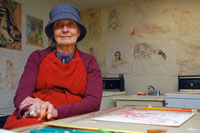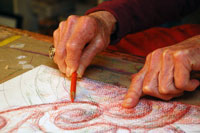Editorials
 Art, Alzheimer's and acceptance
Art, Alzheimer's and acceptance
By Margaret Potchatek
For the Examiner
Feb 4 2009
Artists Sarah Wallace and Ivan Neaigus have created the kind of simple, graceful life that evokes admiration and wistfulness in those of us who cannot seem to disengage from the frenzy and superficiality of lesser lives.
Surrounded by the damp beauty of pine and madrona woods, there is a quiet dignity to the daily routine as Ivan prepares the morning meal, draws Sarah's bath, and then sharpens and lays out, in orderly rows, an array of colored pencils for their day's work.
There is an aura of peace and tranquility that is particularly present in their studio. Sarah herself exudes a rare, natural beauty, with high cheekbones, blue eyes, and clear porcelain skin. Surrounded by her sketches from an earlier period, she sits at her work table with a welcoming grace and personal warmth that invite you to stay awhile.
 "Sarah has a pleasant disposition," Ivan observes. "She's physically healthy and young at heart. It is wonderful to be around her."
"Sarah has a pleasant disposition," Ivan observes. "She's physically healthy and young at heart. It is wonderful to be around her."
It has not always been so, Ivan explains: "As Sarah began to change, I was completely bewildered by the mystery of how to deal with the situation," he said. "Looking back on it, I think I was desperately trying to hold onto the freedom and creative center that had characterized our lives before."
When Sarah Wallace was diagnosed with Alzheimer's in 2001, Ivan rushed from crisis to crisis throughout the day as the woman he loved slipped behind a dark veil of illness. Struggling to create a life around her condition, he found himself shunning the frantic quest for what he calls "a silver bullet" that would reverse the relentless course of the disease, and sought, instead, a more creative and innovative way to restore the quality of their daily lives.
"I eventually realized that the more peaceful I was with Sarah's condition, the better it became," he said. "Out of that realization, I began to develop a very structured approach to each day, with dinner at a certain time, walking through the woods at certain times, and working on our art at certain times."
"As the disease progressed, we became more socially isolated," he said. "I slowly came to accept that I don't need to be tantalized by the world and the way that others live in the world, and I developed what I would call a practice comparable to a Buddhist discipline."
Ivan explains that sharpening and organizing Sarah's pencils is now an important part of that daily practice: "I prepare the work place. I tape down the paper onto the woodwork surface. Then I lightly sketch an abstract form to contain and stimulate Sarah's creative impulses. Sarah does the rest. She selects all the colors and creates the final product."
As he began to explore ways of adapting to Sarah's disability, Ivan discovered a book entitled "Montessori-Based Activities for Persons with Dementia" by Cameron J. Camp, Ph.D., at Myers Institute in Beachwood Ohio. Consistent with the basic Montessori theory, the quality of Sarah's life began to improve significantly as Ivan began to offer her opportunities to engage in art activities that were compatible with her restricted yet substantial artistic ability. By restoring a sense of purpose to her day, he was creating opportunities for accomplishment and personal satisfaction that had nearly disappeared. Once again, he and Sarah could work side by side as artists.
Eight years later, Ivan describes himself a mentor who facilitates the artistic process for Sarah, the artist-patient. Sarah's genre has shifted from stylized realism to deep abstraction as her condition has progressed. She has recently completed a 32-piece collection of abstracts called "Transitions" which will be on display in Langley through March 2009. Significantly, the artist's mastery of the fundamental elements of art remains intact in spite of her progressive illness. Her pencil drawings still retain the fluid, emotionally compelling qualities that characterized her earlier stylized realism.
Sarah's work conveys the feeling that she has captured the emotional process of her private descent into the mysterious world of Alzheimer's. Relying on a rich color palette of compatible, natural autumn colors, her works express a depth of perspective and clarity of form that draw the viewer in toward a series of seductive and mysterious focal points. Discrete areas of light add warmth, movement, and dimension that make her collection hard to resist.
Musing over the irony and the blessing of Sarah's condition, Ivan said he has come to terms with life as it is, rather than focusing on how things were before.
"As an artist you are always pursuing that "no-mind" state that allows you the freedom from self-imposed inhibitions that restrict the creative process," he said. "It is strange, really, that Alzheimer's has permitted Sarah to live continually in that no-mind state, and that her condition has given me the opportunity to live with her in that state so that she can continue her work as an artist."
As a young woman, Sarah Wallace received her formal education in fine arts at University of California at Berkeley. While at Berkeley, she was a popular coed and an active member of the Alpha Phi sorority. After college she worked briefly for McDonnell Douglas before moving to Malibu, where she raised three daughters and developed a distinctive body of stylized realistic work.
Widowed at a young age, she and Ivan met at a dance in a coffeehouse in Malibu where creative dance and artistic innovation were fostered.
"She was very much a Mother Earth, California girl, living in her beach house, raising three teenage daughters," he said. "It has been such a wonderful life together; movies, dinners out, sharing our art, enjoying our friends."
She and Ivan moved to Langley in 1984 and quickly became a part of the Whidbey Island art community. During that period, Sarah produced a substantial body of work. In 1994 she earned first prize at Langley's Choochokam Festival of the Arts and participated in various shows and art studio tours.
It is Ivan Neaigus' hope that his successful use of the creative process as a healing tool for Sarah will help other family and professional caregivers create their own healing environments for those afflicted with Alzheimer's and other forms of dementia.
Stepping away from the serenity of their wooded place, Ivan's stone and wood sculptures stand quiet sentinel along the rustic gravel drive, tangible evidence of the vigor of two artists in an earlier time.